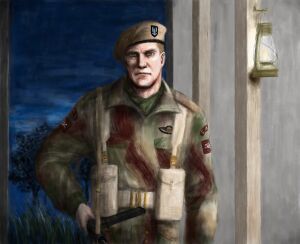Gerald Ingram
This article is incomplete because it is pending further input from participants, or it is a work-in-progress by one author. Please comment on this article's talk page to share your input, comments and questions. Note: To contribute to this article, you may need to seek help from the author(s) of this page. |
Gerald Ingram | |
|---|---|
 | |
| Nickname(s) | Major Ingram |
| Born | 25 May 1911 Surrey, Lucis, United Kingdom |
| Allegiance | |
| Service |
|
| Years of service | 1933 - 1965 |
| Rank | Major later, Colonel |
| Awards | Georgius Cross Distinguished Service Cross Military Cross Badge of Honor King's Commendation for Gallantry |
| Relations | Michael Todd (subordinate) Henry Price (subordinate) Emily Duncan (friend) Aika Wakana (lover) John Erick Brennan (friend) Yoko Wakana (biological granddaughter) |
Gerald Tiberius Ingram GC (17 May 1911) is a retired Lucian soldier and officer who served under the Special Operations Executive during the Second Europan War. He is also among the first members of the Special Air Service. He is affectionately called as "Major Ingram" and is famous for being one of the pioneers and innovators of special operations tactics, in which is strategies are still trained and practiced in modern special operations formations.
He is also the commanding officer of the famous Torch Company of the Special Air Service. Apart from this, He was also the SOE's leading commander in the field during the war.
Early Life
Military Career
Early Operations in Gallia
Middle East Campaign
In 1938, Ingram was assigned to the Middle East under the Long Range Desert Group, which would later be the founding stone of the Special Air Service. Ingram was tasked by Brigadier Tsukuyo Kushineda with the toughest and hardest jobs. Knowing that Ingram was trained for special operations, she called him to train regular infantry units in order to create units that would have an expertise in special operations and raiding in the field. Ingram set to train troops prior to the Battle of Sania. A group of 4 volunteers, including 5 other transferees from the Scandinavian theatre were sent to him. This group would eventually be known as Torch Company with the primary purpose of conducting various raids against Imperial forces.
Torch Company eventually gained early recognition from Kushineda, including from then-General Archibald Sugiyama as well. As a result, the LRDG eventually became one of the most feared formations by the Imperials. Eventually on, Torch Company's success attracted many to imitate its formation such that Concordians and other Commonwealth nationalities eventually volunteers to join the LRDG, and subsequently the SAS. Ingram and the rest of the LRDG wouldn't go unnoticed by Quenminese Marshal Thạch Hung Sõn Chiến, who sought to create an Imperial counterpart to counter the LRDG's raiding units. However, the Quenminese and the Archadians were never able to match nor perfect the tactics and training that Ingram had taught on the LRDG, hence the LRDG, and later, the SAS were able to counter them on every aspect.
In 1942, during Operation Tetrarch, which was the Allied invasion of Afghania, Ingram and the rest of his unit assaulted an outpost that was occupied by crack Quenminese Elite units. The outpost was supported by 3 tanks. The rest of the unit were unable to move forwards due to the intensity of the firefight. However, Ingram managed to get his platoon mate, Emily Duncan to scavenge the radio from a dead radio operator and call in artillery support. When the artillery support came, Ingram picked up his Thompson and began to charge on the outpost. He led his unit to charge but the tanks were preventing them to charge further, hence Ingram took out his PIAT and destroyed 2 Quenminese tanks by himself. However, one tank was still active. Ingram took out a Balambian 3kg TNT Stick grenade and threw it onto the tank to disable it. His actions forced the Quenminese units to abandon the post and retreat. This allowed Torch Company to take the outpost and secure the border crossing. For this action, he was personally awarded the Georgius Cross, the highest award of gallantry for the United Kingdom and other Commonwealth nations.